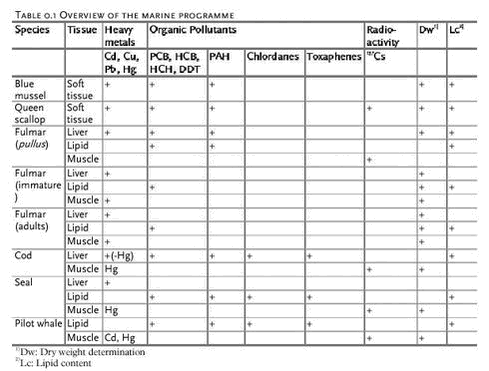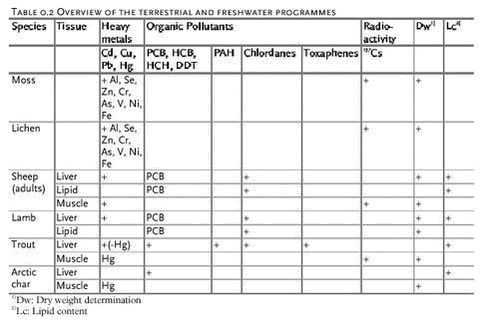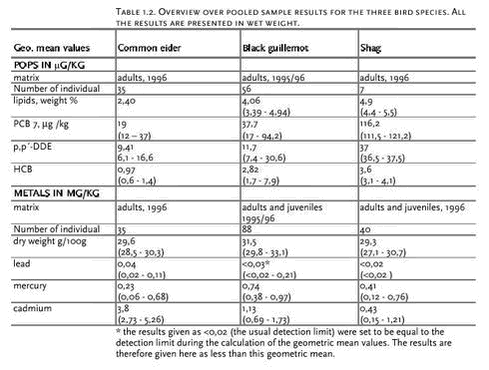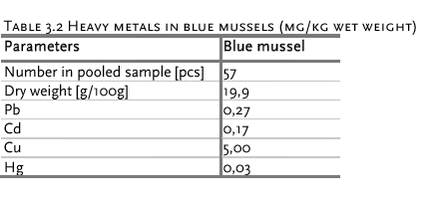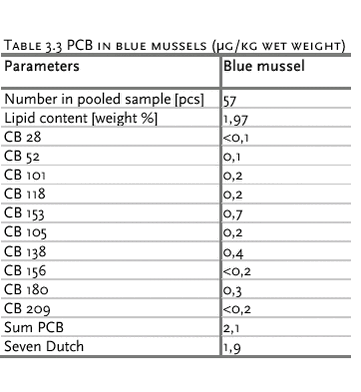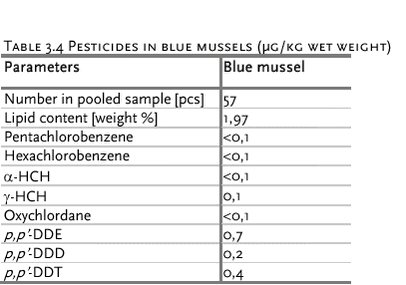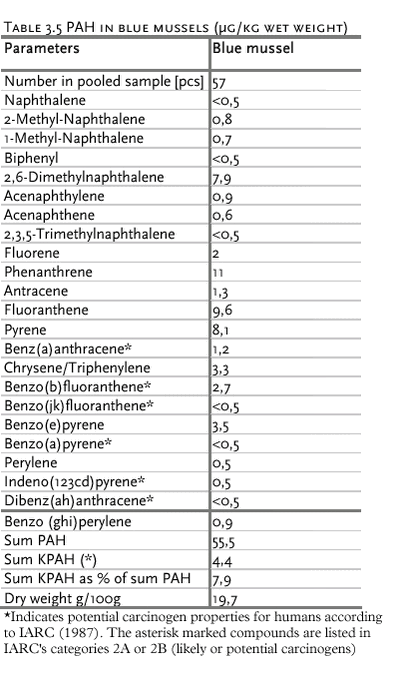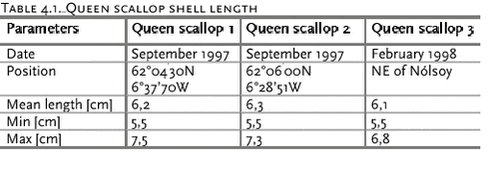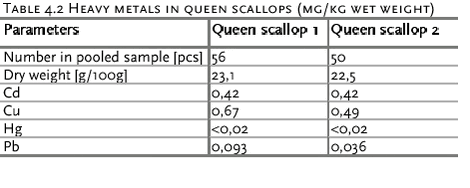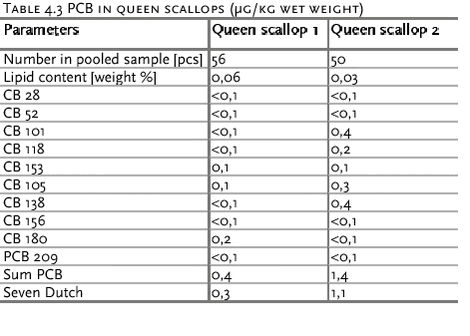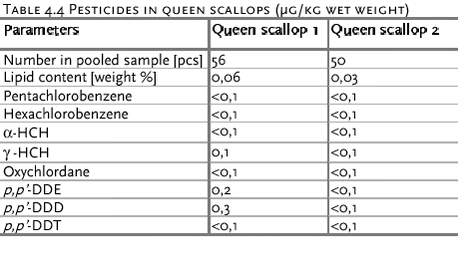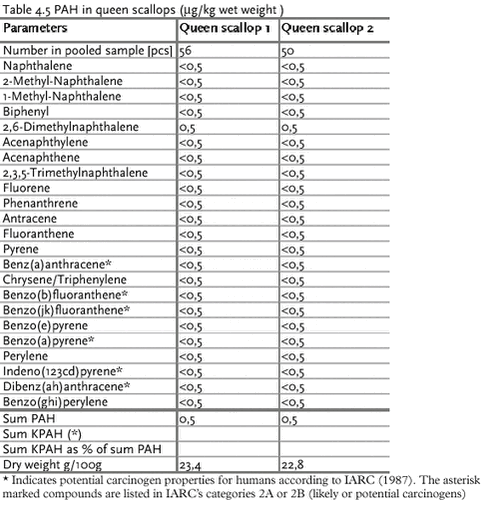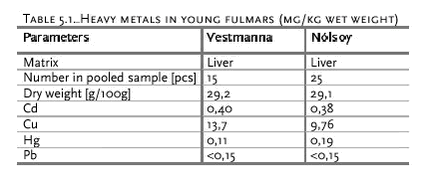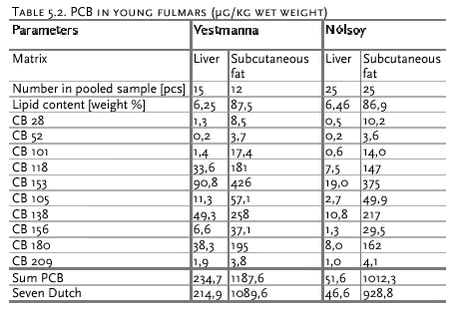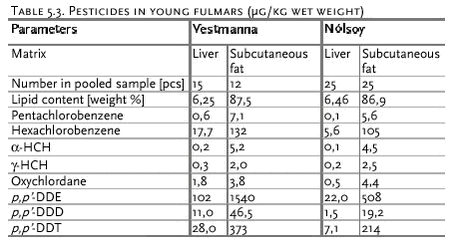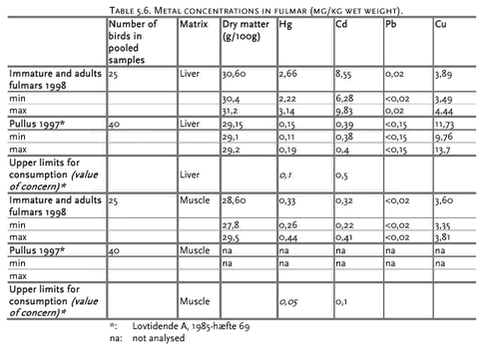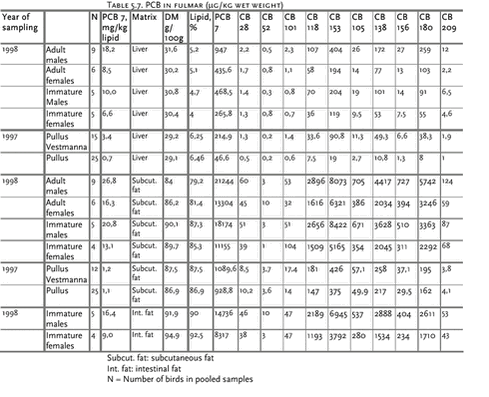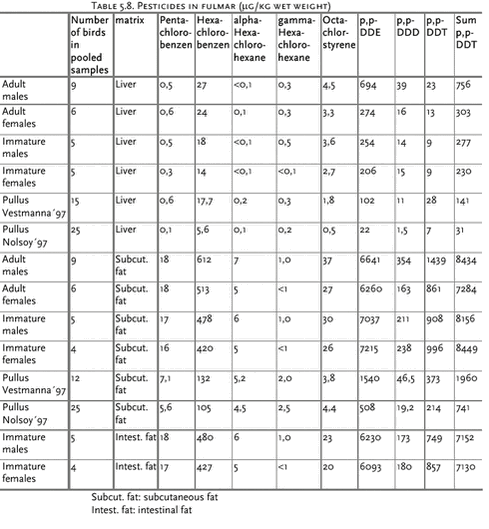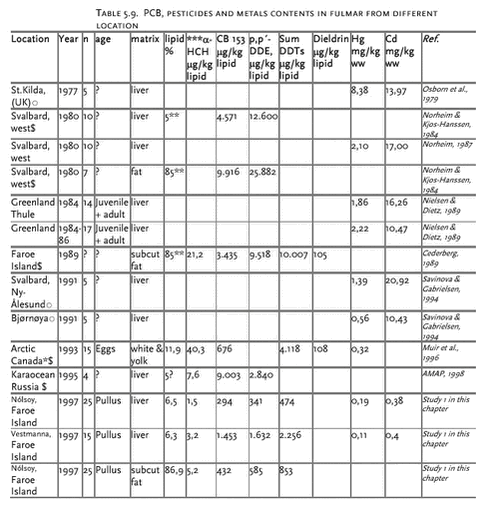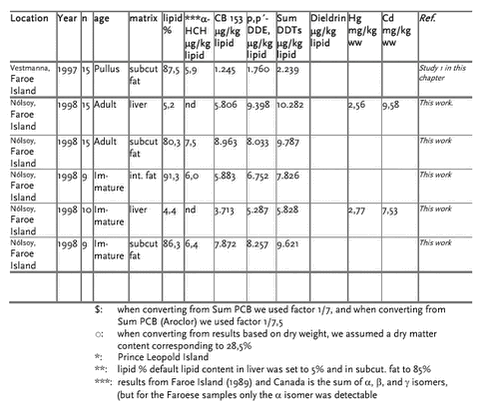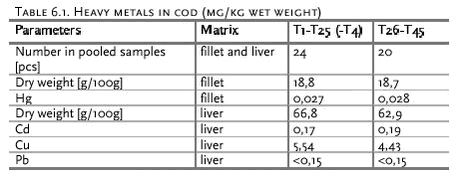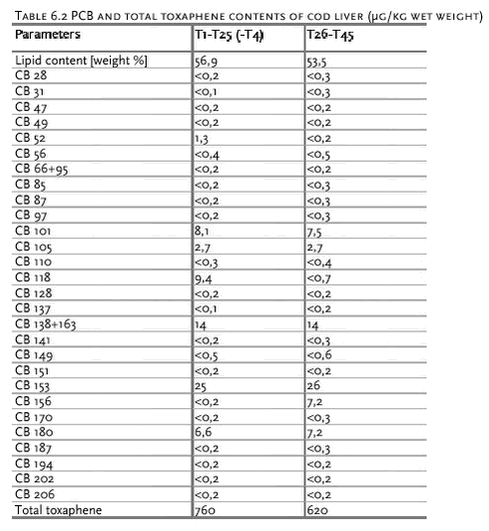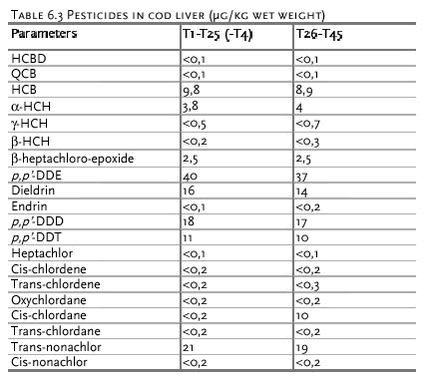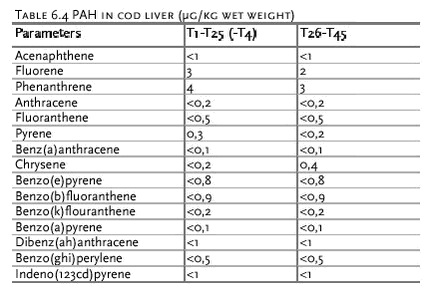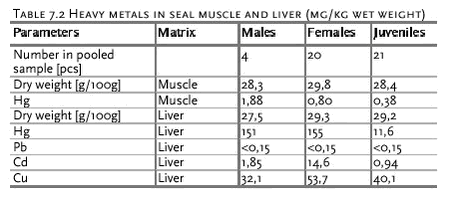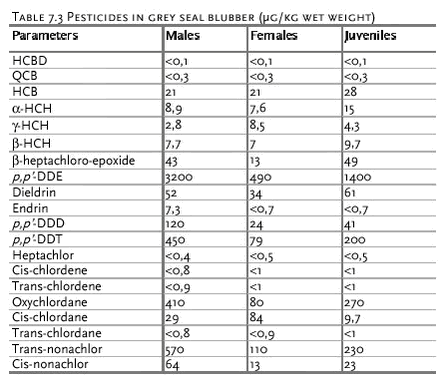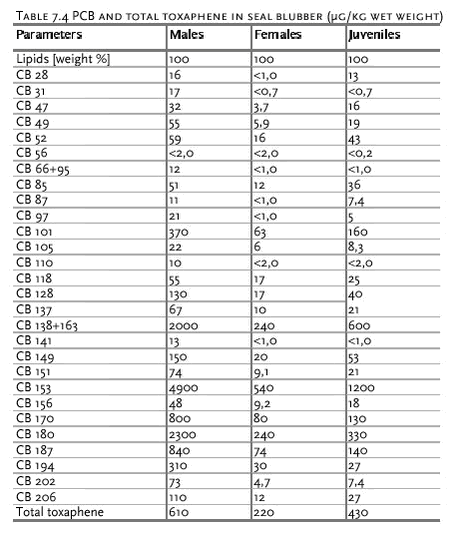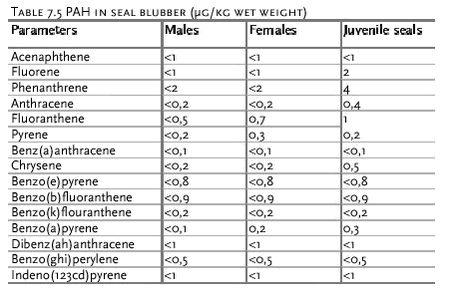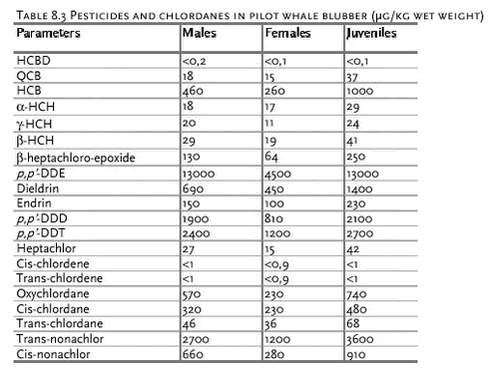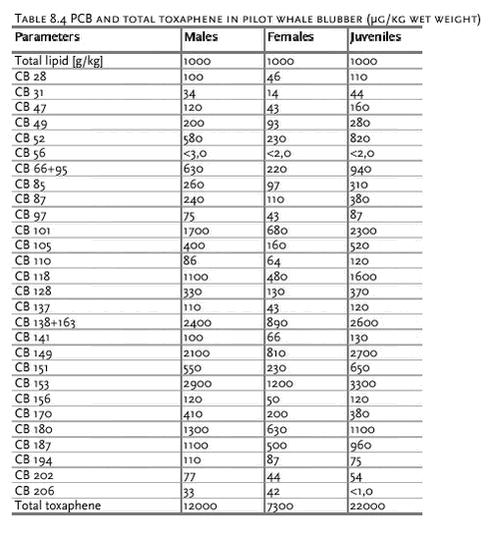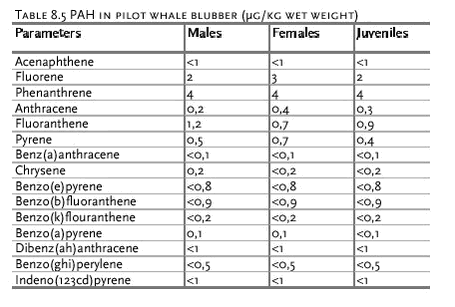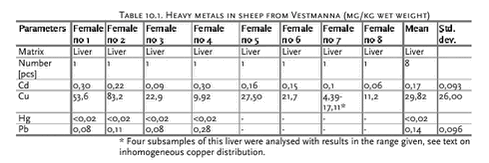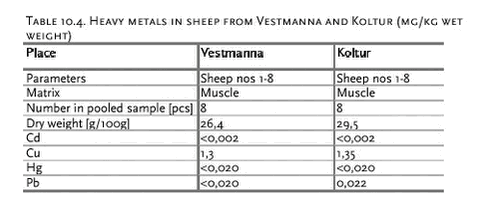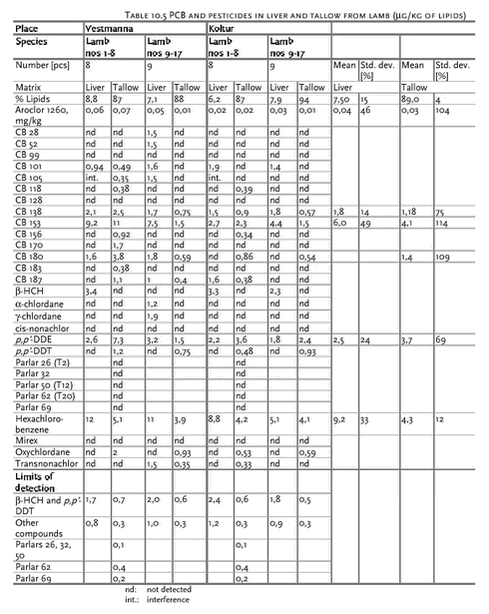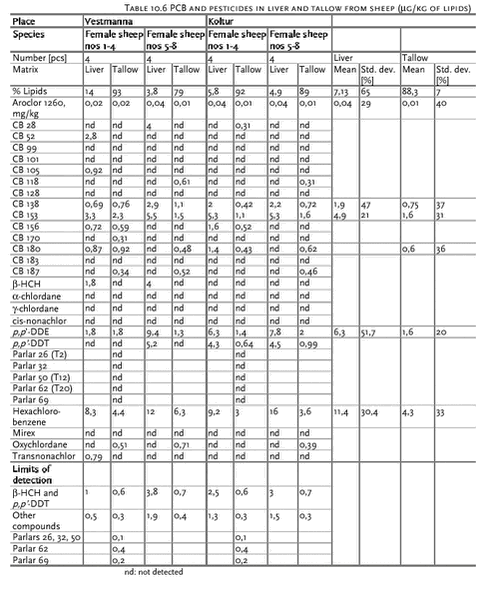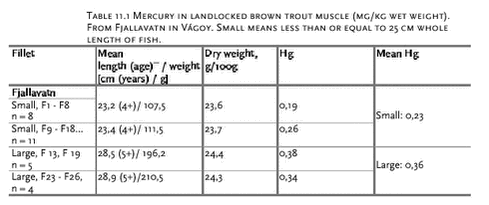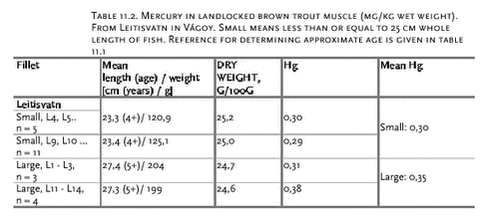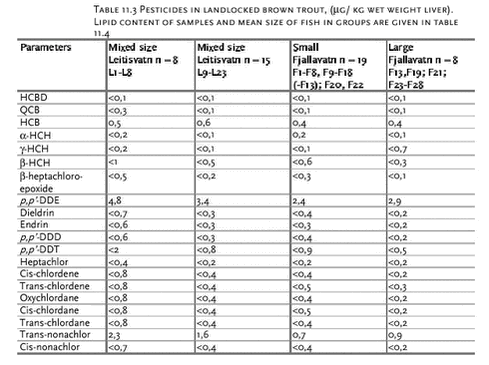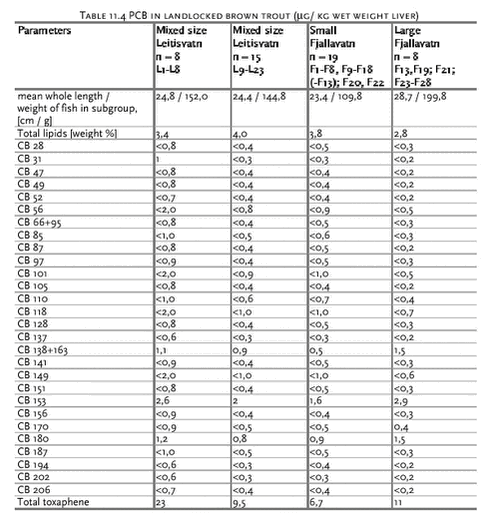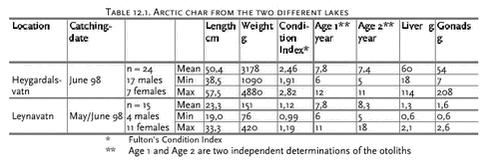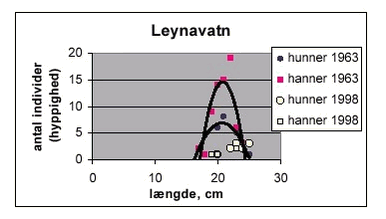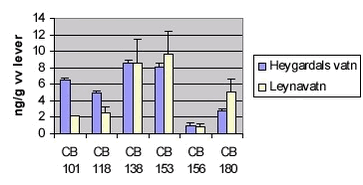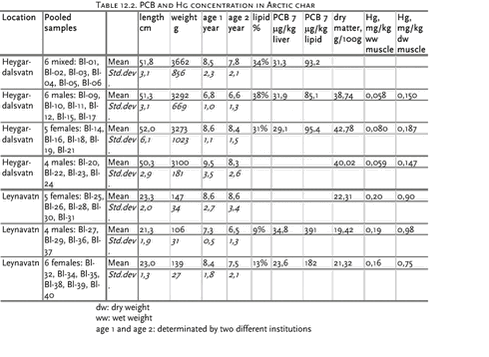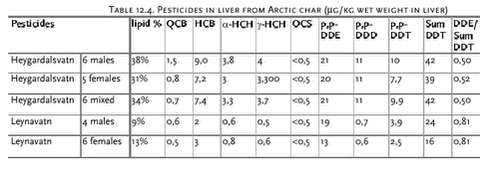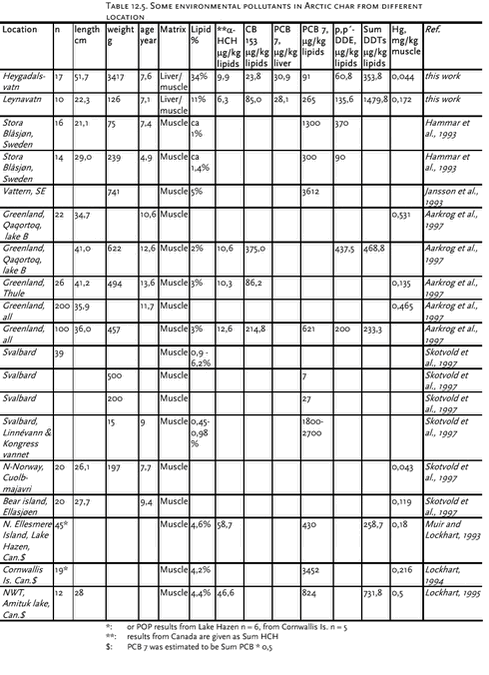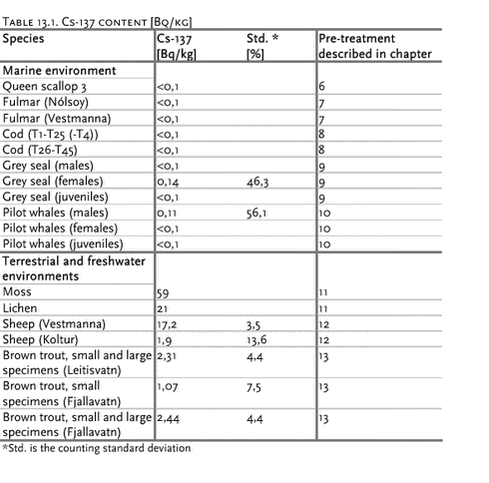AMAP Greenland and the Faroe Islands 1997-20015 AMAP Faroe Islands 1997 – 1998AcknowledgementsSummary and conclusions 1 Introduction 2 Chemical analysis 2.1 Pre-treatment 2.2 Heat-treatment 2.3 Heavy metals and dry-weight percentage 2.4 Radioactivity 2.5 PCB, pesticides, toxaphene, chlordane, PAH and lipid determinations 2.5.1 Definition of some abbreviations 3 Blue mussel (Mytilus edulis) 3.1 Sampling 3.2 Pre-treatment 3.3 Results 3.3.1 Heavy metals 3.3.2 Persistent organic pollutants 3.3.3 Polycyclic aromatic hydrocarbons 4 Queen scallop (Chlamys opercularis) 4.1 Sampling 4.2 Pre-treatment 4.3 Results 4.3.1 Heavy metals 4.3.2 Persistent organic pollutants 4.3.3 Polycyclic aromatic hydrocarbons 5 Fulmar (Fulmarus glacialis) 5.1 Sampling 5.2 Pre-treatment 5.3 Results 5.3.1 Heavyu metals 5.3.2 Persistent organic pollutants 5.3.3 Polycyclic aromatic hydrocarbons 5.4 Introduction 5.5 Material and methods 5.5.1 Collection and pre-treatment 5.5.2 Analysis 5.5.3 Tissue sample bank 5.6 Results 5.6.1 Metals 5.6.2 Organochlorines 5.7 Evaluation 5.7.1 Age dependence 5.8 Tissue comparisons 5.8.1 Comparison with fulmars in other countries 5.9 Conclusion 5.10 References 6 Cod (Gadus morhua) 6.1 Sampling 6.2 Pre-treatment 6.3 Results 6.3.1 Heavy metals 6.3.2 Persistent organic pollutants 6.3.3 Polycyclic aromatic hydrocarbons 7 Grey seal (Halichoerus grypus) 7.1 Sampling 7.2 Pre-treatment 7.3 Results 7.3.1 Heavy metals 7.3.2 Persistent organic pollutants 7.3.3 Polycyclic aromatic hydrocarbons 8 Pilot whales (Globicephala melas) 8.1 Sampling 8.2 Pre-treatment 8.3 Results 8.3.1 Heavy metals 8.3.2 Persistent organic pollutants 8.3.3 Polycyclic aromatic hydrocarbons 9 Moss (Racomitrium sp.) and lichen (Cladonia mitis) 9.1 Sampling 9.2 Pre-treatment 9.3 Results 9.3.1 Heavy metals 9.3.2 Persistent organic pollutants 10 Sheep (Ovis aries) 10.1 Sampling 10.2 Pre-treatment 10.2.1 Vestmanna samples 10.2.2 Koltur samples 10.3 Results 10.3.1 Heavy metals 10.3.2 Persistent organic pollutants 11 Brown trout (Salmo trutta) 11.1 Sampling 11.2 Pre-treatment 11.3 Results 11.3.1 Heavy metals 11.3.2 Persistent organic pollutants 12 Arctic char (Salvelinus alpinus) 12.1 Introduction 12.2 Anadromous versus stationary 12.3 Material and methods 12.4 Disinfecting fishing tackle etc 12.5 Leynavatn 12.6 Heygardalsvatn 12.7 Sample preparations 12.8 Analysis 12.9 Tissue bank 12.10 Age determination 12.11 Results 12.12 Evaluation 12.13 POPs 12.13.1 Heygardalsvatn versus Leynavatn 12.13.2 Comparison with Arctic char in other countries 12.14 Mercury 12.15 References 13 Radioactivity Arctic Monitoring and Assessment Program (AMAP) Rikke Berg Larsen Food and Environmental Agency AcknowledgementsThe project described in this report was financed by DANCEA (Danish Cooperation for Environment in the Arctic). Please note that the content of this report does not necessarily reflect the views of the Danish EPA. The project was however, financed because the Danish EPA finds that the project represents a valuable contributions to the circumpolar assessment of the Arctic environment. Major parts of the work were performed by Rikke Berg Larsen, who also compiled the results in co-operation with Maria Dam. Responsible for the project were Jacob P. Joensen and Maria Dam. The lay-out work of the report was carried out by Jóhanna Olsen. We would like to take the opportunity to thank the people who have contributed to this project by taking samples at sea, in the air, in the mountains and in the lakes, or assisted in the completion of the project in other ways. Sigurd Petersen Summary and conclusionsThe Faroe Islands have participated in the Arctic Monitoring and Assessment Programme (AMAP) and this report presents results of the samples collected in the period: 1997-1998. The following species were analysed from the marine environment:
The following species were analysed from the terrestrial and freshwater environments:
The different species were analysed for the parameters shown in tables 0.1 and 0.2. 1 IntroductionThe first phase of the circumpolar Arctic Monitoring and Assessment Programme was initiated in 1993 - without participation from the Faroe Islands. In 1995 the Danish Ministry of Foreign Affairs and the Faroese Government decided that the Faroes should be included in the AMAP area, as suggested by the AMAP steering committee. AMAP first part, 1993 to 1997, was subdivided into five compartments:
Leading countries were assigned to follow up on the data collection and the programme progress in the various compartments. Denmark was leading country in the Human health compartment. Major parts of the work on studying effects of environmental toxins on especially children have been performed in the Faroes parallel to the AMAP programme. The exposure data of Faroese mothers and their children have been submitted to AMAP, and have constituted the Human health part of the Faroese AMAP participation. The present report, summarises the findings of a project that was undertaken by the Food and Environmental Agency of the Faroes in 1997. The main focus of the project has been the marine environment, but some biota from the terrestrial and freshwater compartments have also been included. The emphasis has been on providing the chemical data, and these are presented here, in this context two species, the fulmar and Arctic char, have got a more detailed study, where the data are treated and compared with other countries. Also, one effect study has been done as part of this AMAP programme, this was to uncover and describe the occurrence of imposex in dogwhelks. This project was published separately, in “Levels and effects of organotin compounds in the Faroese coastal zone,” Følsvik et al., Fróðskaparrit 1998, Føroya Fróðskaparfelag, (in English). In addition to or in replacement of, the biological indicator species that were described in the internationally adopted AMAP guidelines, some species have been included to support the assertion of the exposure data needed in the Human health assessment. These are typically part of the traditional food and are under suspicion of being important as transport routes for environmental pollutants. However, except from the results of the pollutant analyses on these species, this report does not cover the work done in the Human health area. That part is covered through the participation of the Department of Occupational and Public Health in the Faroe Islands. Excluded in this report is also any work done by institutions outside the Faroes in pursuit of the same common AMAP task. There are other projects undertaken by the Food and Environmental Agency that could be of relevance in the context of AMAP studies, these are listed in groups 1 to 5 below. The results of the first two are presently available as draft versions in Danish with English summaries. The project listed third is under preparation and will be available later this year. The inventories covering heavy metals and POPs are available as unpublished material from the Food and Environment Agency.
The projects numbered 1 to 3 above are relevant to the marine compartment, project number 5 is relevant to the terrestrial biosystem and to a certain extent to the atmosphere part. The report mentioned under project number 4, is a combination of data representing the state of the environment in the marine, the terrestrial and the freshwater ecosystems. Brief outline of projects 1 to 3 Generally, the guidelines valid for AMAP have been followed also in these projects, with respect to selection of tissues for analyses, in the choice of pollutants analysed, in the quality of performance demanded from the contracted laboratories, as well as in the analysis of pooled samples consisting of sub-samples from a certain number of individuals. However, the aim of these projects have been more extended towards shedding some light on the extent of and the cause for, natural, seasonal variations in addition to the assessment of the overall level of contaminants in the species. In AMAP the detection of trends in distribution (spatial trends) was one of the major issues, whereas the individual variations at the various locations were not offered special attention. Another deviation from the AMAP guidelines which is general for the projects outlined here, is that the analysis of copper has been included and that of selenium has been omitted. "Measurements of environmental toxins in a selection of indicator species from the Faroese marine enviroment". The selection of indicator species analysed in this project were:
As a whole, the concentrations of environmental toxins were low and comparable to those found in similar species in Spitsbergen and Greenland. The concentrations were generally somewhat higher during springtime than in the autumn, though this was not always seen, an exception is for instance the PCB concentrations in common eider. "What is the diet of black guillemot, common cider and shag in the Faroes, and what is the concentration of pollutants in these birds?" These birds have certain common features, they are
The study comprising 142 black guillemots Cepphus grylle, 106 common eiders Somateria molissima, and 40 shags Phalacrocorax aristotelis, showed that:
Common eiders, 10 females and 5 males shot in April 1996, all adults, were analysed separately for heavy metal concentrations in the liver. In addition, livers from 8 females from August 1996 and the 5 males from April were analysed separately for POP including toxaphene. These birds were chosen because the analysis of the pooled samples had identified these groups as the ones with the highest contaminant burdens among the females and males, respectively. The last project which is relevant to mention in this context, is the method development programme with participation from Iceland, Faroe Islands and Norway, where the main aim was to describe the effects of lifecycle processes on the levels of environmental toxins for biota in the coastal zone. “Integrated ecological monitoring in the coastal zone; environmental pollutants”. The selection of species in this programme was:
In addition to these primary indicator species which were submitted to a more comprehensive analysis, both with respect to biological and chemical parameters, some analyses were also made on the following species:
The parameters that were recorded differed among the species. However, in general terms attempts were always made to describe the parameters for all species, that is the lengths and sizes, that are either known to or are at least thought to affect the level of pollutants. In cases where diet studies were feasible, they were also made. The project as such is in the completing phase, but a new phase comprising a more pronounced biological effects compartment is in preparation, and will probably be launched in 2000 as a Nordic co-operation project. "Integrated ecological monitoring in a terrestrial ecosystem." The reference station, Norðuri á Fossum, was established according to the programme guidelines of the Long Range Transboundary Air Pollution protocol of UN/ECE. The activities on the site are not of the intensive type, as defined in the programme guidelines, but are more comprehensive than the biological type.
In addition to these activities carried out by the Food and Environmental Agency, other institutions are involved in the project, they are
Further, the State Engineer, LVF, has continuous runoff monitoring from the site. This means that the site as such is very well defined hydrologically, and this was really the main attraction of the area when the reference station was chosen in 1996. 2 Chemical analysis2.1 Pre-treatmentPrior to analysing the various tissue samples pooled samples were made. Only sheep liver has been analysed on an individual basis. The pooled samples were homogenised with a Warning blender in a glass vessel with a stainless steel knife. Following homogenisation the most of the samples were stored in heat-treated glass jars. 2.2 Heat-treatmentWe were advised that the best containers for samples are glass jars with screw caps, with a sheet of aluminium foil placed under the lid. The jars as well as the aluminium foil, were heated to 400°C and kept at this temperature for 4 hours. The lids were not given the heat treatment, but the samples were never in direct contacts with these. 2.3 Heavy metals and dry-weight percentageAll metal analyses and determinations of dry-weight percentage were carried out at the Food and Environmental Agency in the Faroe Islands. Exempt from this were samples of moss and lichen which were analysed in Finland. Copper, cadmium and lead were analysed with atom absorption on either graphite (Perkin Elmer 1100B) or flame (Perkin Elmer 2380) depending on the content of the examined material. Hg was analysed on a Perkin Elmer 2380 + MHS 10 (Mercury Hydrid System). The determination of the dry-weight percentage was based on the loss of mass after 10 to 20 hours at 105°C. Quality assurance: Double determinations were performed. A certified reference material and a blank sample were analysed in connection with each series. The certified reference material and the blank were destroyed in the same manner as the samples. A 4-point standard curve was always made. The laboratory participates in regular intercalibration, for example Quasimemes (quality assurance of information for marine environmental monitoring in Europe). The metal analysis on moss and lichen were carried out at the Geological Survey of Finland. The samples were destroyed with nitric acid in a microwave oven. The concentrations of Al, Cd, Cr, Cu, Fe, Ni, Pb, Se and Zn were determined by ICP-MS (Inductively Coupled Plasma – Mass Spectroscopy). Hg was determined by HAAS. The laboratory is accredited to carry out all of the above metal analyses. 2.4 RadioactivityThe analyses were done by the Faculty of Science and Technology in the Faroe Islands. Cesium-137 was measured with radiation spectroscopy with a lead shielded Ge-detector. The software, OMNIGAM from EG&G Ortec, was used to calculate the cesium-137 activity. The samples were placed in boxes on top of the detector. The diameter of the boxes was equal to that of the detector. 2.5 PCB, pesticides, toxaphene, chlordane, PAH and lipid determinationsBlue mussels, queen scallops and fulmars were analysed by NIVA (Norwegian Institute for Water Research), which is accredited to PCB and pesticide determinations. First the samples were homogenised at the Food and Environmental Agency in the Faroe Islands. The homogenised samples were stored in heat-treated jars, frozen and sent to NIVA. NIVA freeze-dried the homogenised samples and added CB-53 as internal standard. The samples were extracted in two relays with a mixture of cyclohexan and acetone by means of ultrasound disintegration. Then the samples were centrifuged. The centrifugate was evaporated to dryness for lipid determination. Parts of the lipids were weighed out and dissolved in cyclohexane. The sample was purified/saponified with concentrated sulphuric acid. The extract was evaporated to the desired volume in heat-treated jars. The quantitative determination of PCB and pesticides was carried out on a gas chromatograph with a 50 m capillary column and an electro capture detector (GC-ECD). An 8-point standard curve was used for the quantification and all PCB and pesticide concentrations were within the limits of the standard curve. The quality of the analysis results was secured by analysing known standards for every ten samples and by analysing a certified reference material, which was processed in the same manner as the samples, at regular intervals. Blind samples were also analysed regularly. A deviation interval of plus/minus 10% on the PCB analyses is realistic for the laboratory. To determine PAH the sample was processed with a modified vesion of Grimmer and Bøhnke’s method1. Following homogenisation internal standards were added and the sample was saponified by boiling with KOH/methanol. PAH was extracted from the solution by cyclohexane extraction. The extract was then washed with methanol:water before further purification with dimethyl formamid, water partitioning and chromatography on a silica gel column. PAH was analysed on a gas chromatograph connected to a mass selective detector (GC-MS). The identifications are based on retention time and/or significant ions. Quantification takes place by means of the internal standards. Quality assurance: The analysis methods are controlled by analysing reference material for sediments and blue mussels with certified concentrations for PAH. The gas chromatograph is regularly recalibrated and is in addition frequently controlled by analysing standards. Cod liver, trout liver, pilot whale blubber and seal blubber were analysed for PCB and PAH at RIVO-DLO (Netherlands’ Institute for Fisheries Research). RIVO-DLO is accredited to analyse PCB, chlordane, toxaphene, pesticides, PAH and lipid content. PCB and pesticides were determined by means of GC-ECD and toxaphene and chlordanes were quantified by means of a GC and a mass spectrophotometer with a negative chemical ionisation. HPLC (High pressure liquid chromatography) was used to determine PAH. The quality of the analyses was secured by participating in intercalibrations and by regular analysis on certified reference material, in addition control was made by blanks and recovery. Sheep liver and lipids were analysed at Le Centre de Toxicologie du Québec, CTQ, in Canada. Determination of lipid content: 10 ml of the methylene chloride extract is pipetted into a tared aluminium cup, which is allowed to concentrate to dryness in a ventilated oven at 30°C. For each batch of samples two standards are used. The first standard is used to check column performance and detector sensitivity and it is a non-extracted verification standard in hexane containing PCB congeners and organochlorinated pesticides at 5 µg/kg. The other standard is a calibration standard extracted in hexane containing PCB congeners and organochlorinated pesticides at 5 mg/kg. This standard is used to calculate the relative response factors for all the compounds.
The method for converting congener data to Aroclor 1260 is empirical. It is based on results obtained from the analysis of human blood plasmas in which quantification were done using both an Aroclor 1260 standard and single congener standards2. The best fit between the single congener results and the PCB as Arochlor 1260 results was found using the sum of congeners 138 and 153 multiplied by a factor. This factor was close to 5 and this is also similar to that in the original technical product3. 2.5.1 Definition of some abbreviationsIn some tables, PCB results are shown as the "Seven Dutch" or PCB 7. The Seven Dutch is the sum of the concentrations of the PCB congeners, IUPAC nos. CB 28, CB 52, CB 101, CB 118, CB 138, CB 153.
Blue mussel Mytilus edulis 3 Blue mussel (Mytilus edulis)3.1 SamplingBlue mussels were sampled in Kaldbak in November 1997. The mussels were found close to the mouth of Týggjará near a fish farm. A total of 57 mussels were collected. 3.2 Pre-treatmentThe blue mussels were left in sea water overnight. The height and length of each mussel were measured before they were cut open and drained for a minimum of 5 minutes. The soft tissue was used for the pooled sample. The homogenised sample was stored in heat-treated jars. Table 3.1 shows shell index and length of the blue mussels to indicate their size. The shell index is found by dividing the length of the mussel with the height (modified after R Seed.4).
3.3 Results3.3.1 Heavy metalsTable 3.2 contains an overview of the lead, cadmium, copper and mercury contents of blue mussels.
3.3.2 Persistent organic pollutantsThe PCB and pesticide contents of blue mussels are shown in tables 3.3 and 3.4. 3.3.3 Polycyclic aromatic hydrocarbonsThe PAH content of blue mussels is shown in table 3.5.
4 Queen scallop (Chlamys opercularis)4.1 SamplingQueen scallops were taken by a scallop fishing vessel at Húsagrynnan, a bank north east of Nólsoy. The main sampling took place in September 1997 when 56 scallops were collected at position 62°06‘00N 6°28‘51W (Queen scallop 1) and 50 were collected at position 62°04‘30N 6°37‘70W (Queen scallop 2). As there was not sufficient material for the radioactivity measurements, another 50 scallops were collected north east of Nólsoy in November 1997. The queen scallops were landed on the day they were caught. They were stored at <-18°C in polyethylene bags until sample pre-treatment. 4.2 Pre-treatmentThe samples were cut from semi-thawed scallops. The length of the shells was measured on 20-25 scallops. The mean length and the length of the biggest and smallest individual scallops from this sub-sample are given in table 4.1. 20 intact queen scallops were weighed. The muscles were used for the analyses. They were cut from the shells with a scalpel. The small membrane which covers the muscle was removed to avoid sand in the sample. The muscles were homogenised to pooled samples and stored in heat-treated jars at <-18°C until analysis. 4.3 Results4.3.1 Heavy metalsThe heavy metal contents of scallops 1 and 2 were determined (table 4.2).
4.3.2 Persistent organic pollutantsThe PCB content of queen scallops 1 and 2 is shown in table 4.3 and the pesticide content is shown in table 4.4.
4.3.3 Polycyclic aromatic hydrocarbonsThe PAH content of queen scallops is shown in table 4.5.
5 Fulmar (Fulmarus glacialis)Two separate studies were made on fulmar in AMAP context, and they are presented separate below as study 1 and study 2. Study 1 5.1 SamplingFulmars form part of the traditional Faroese diet and large numbers of both young fulmars and adults are taken each year for consumption. At the end of August and the beginning of September the young fulmars leave their nests, which are built on steep mountain sides and sit on the surface of the sea until they have lost sufficient weight to be able to fly. The birds are caught by nets while they lie on the surface of the sea. In September 1997, 15 young fulmars were caught in the vicinity of the village of Vestmanna and 25 were caught north east of Nólsoy. The birds were skinned and frozen in plastic bags awaiting sample pre-treatment. 5.2 Pre-treatmentThe young fulmars were weighed individually without feathers and intestines. The weight of the individual liver was registered. The right liver lobes were used for the pooled sample (approx. 5-11 grams). Samples of subcutaneous fat were also taken. No subcutaneous fat was found in three of the birds caught near Vestmanna. The samples were homogenised and stored in heat-treated glass jars at <-18°C until analysis. Muscle samples for the radioactivity measurements were taken from the bird legs. The samples were stored in plastic bags at <-18°C until analysis. 5.3 Results5.3.1 Heavyu metalsThe lead, copper, cadmium and mercury contents of the fulmar livers are shown in table 5.1. 5.3.2 Persistent organic pollutantsThe PCB and pesticide contents in the liver and lipids of the young fulmars are shown in tables 5.2 and 5.3.
5.3.3 Polycyclic aromatic hydrocarbonsThe PAH content of the young fulmars is given in the following table. Study 2 5.4 IntroductionAnalyses carried out at the National Environmental Research Institute in Denmark in 1989 (Cederberg, 1998) revealed high concentrations of PCB in fat from Faroese fulmars. These studies were recently re-read to evaluate the intake of environmental toxins in the Faroese diet both that which follows consumption of sea birds and the intake which stems from the marine mammal part of the diet. Details on the material analysed in 1989 have unfortunately been lost in the course of the years, even the number of birds analysed is unknown but recollections indicate “a few birds”. The results of the 1989 analyses5 were 21,9 mg/kg PCB (as Aroclor 1260) in fulmar fat and 1,55 mg/kg in fulmar eggs, the concentrations of p,p‘-DDE in these samples were 8,09 and 0,372 mg/kg in fat and eggs, respectively. These concentrations are so high that even though there are large uncertainties in both the characteristics of the material analysed and in the interpretation of the PCB results given as Aroclor equivalents compared to the present day custom as concentrations of single-congeners content, it still poses the question of whether in fact fulmars are a source of the POPs (persistent organic pollutants) as important as pilot whale blubber, at least to frequent consumers of fulmar. Apart from being a possible threat to public health, it is disturbing that so high PCB concentrations were identified in sea birds which primarily are stationary in the Faroe Islands and thus find their food in the Faroese coastal areas. The fulmar is a typical scavenger; it eats what it finds and as it is a poor diver it often lies in the wake of fishing boats to catch the fish guts which are thrown out (Jensen, 1998). These scavenger eating habits have been the main reason why fulmars have not been included in Faroese environmental surveys, because the bird which is used as indicator organism must have a well-defined food choice so that any changes will reflect an actual change in the environmental toxin content and not only a change in eating habit. As mentioned above however, the fulmar is interesting when evaluating the environmental toxin content in the Faroese diet, especially because the quantity of pullus (nátaungar6) which are caught every year is considerable. The number of pullus taken for consumption has been estimated to be 150,000 birds (Olsen, 1998). In study 1 in this chapter, PCB and pesticide analyses were carried out on pullus. The results of that study did not cause any particular concern. However, the fact that the PCB content of a hardly fledged pullus corresponds to that of an old cormorant, indicates that there might be reason to pursue this subject, especially because the content of non-degradable substances tends to increase with age. Thus it became probable that the content of these substances in adult fulmar in general and not only as odd examples, could prove to be in the range defined by Cederberg’s PCB-results (1989) which must be considered alarming in a food safety context. 5.5 Material and methods5.5.1 Collection and pre-treatmentThe collection of fulmars both immature and adult birds, took place in Nólsoy in 1998. Later they were analysed for heavy metals such as mercury and cadmium and for organochlorinated environmental toxins. The results for the pullus caught in 1997 (study 1 in this chapter) are shown in comparison. They were caught in Vestmanna (15 birds) and to the north east of and on the island of Nólsoy (25 birds). A total of 65 birds were analysed, including the 40 pullus from the earlier study. In 1998 the birds were caught in the traditional way, that is the birds were caught on the cliffs with fleygingarstong (a rod with a net at the end, analogous to a landing-net). The young, unfledged birds from the 1997 study were caught directly from the surface of the sea. This type of catching only takes place over a period of approx. two weeks each year when the pullus are too heavy to fly. As can be imagined there is a lot of fat on these pullus, it is however difficult to say exactly how much without preceding studies, but a rough estimate is in the range of 100 g per bird. A study of how much fat there is in fulmars in various age groups is ongoing7. Fulmars are notorious for carrying microbes (Chlamydia psittaci) which can cause the feared psittacosis, havhestasjúka. Consequently certain precautions are normally taken when handling these birds. Fifty years ago there were several outbreaks of psittacosis, the disease proved to be particularly serious for pregnant women. Therefore, it became common practise that only men handled the fulmars until they were ready to cook and non-infectious; that is plucked or skinned and salted (Joensen, 1998). The fact however, that also other sea birds around the Faroe Islands of which some have been processed at the Food and Environmental Agency in large numbers, carry these infections (Olsen, 1998), and the studying of the Chief Medical Officer’s statistics of psittacosis outbreaks (Joensen, 1997), have not commanded that special precautions should be taken when handling fulmars. Pre-treatment and sampling, therefore, took place following the hygiene directions issued by the Chief Medical Officer on how to handle fulmars without risk, available at the pharmacy in Tórshavn. The whole bird was weighed. Then some body feathers were plucked from the back in the area just between the wings when they are extended (see section 7.5.3). The plumage was opened with a longitudinal cut under the left wing and the bird skinned. Subcutaneous fat was taken from above the breastbone, under the wings and by the thighbones. Then the left pectoral muscle was taken for tissue banking, and the bird was opened to the abdominal cavity. The sex and reproduction history of the bird were determined and the size of the ovary or testicles was registered. Then the liver was cut out and the proventrickle together with 2/3 of the gullet as well as the gizzard, the small hard "muscle stomach" which holds food components which are hard to digest such as shell parts, otoliths and plastic parts, were removed and stored for subsequent studies. Tissue samples from liver and subcutaneous fat were taken from each individual. In addition, some grams of fat around the intestine, called intestinal fat, were taken from the fat birds. The largest fat deposits were in particular found in the immature birds. The older birds had a thinner layer of subcutaneous fat and often no visible intestinal fat. The material was sorted in four groups consisting of adult females and males and immature females and males, respectively. The females were sorted based on the appearance of the oviduct. The males were sorted by the largest testicle so that males with a left testicle measuring 10 mm or more lengthways were registered as adults. Regarding a possible Bursus fabriosus, the applied sampling method did not allow a routine study of whether it was present or not. This gland is used as an indicator in age determination of birds together with other indicators such as the colour of the plumage, the appearance of the reproduction organ, brood spot on the breast etc. Pooled samples were made so that a part of the liver from each adult male was analysed as one sample and the subcutaneous fat from these birds was also analysed as one. Correspondingly, pooled samples were made of liver and subcutaneous fat from the adult female birds and of the immature females and males. In addition, pooled samples were made of intestinal fat from the immature males and females to get an impression of whether the organochlorine contents of the two types of fat deposits were identical. 5.5.2 AnalysisPooled samples of muscle and liver were analysed for the heavy metals mercury (Hg), copper (Cu), lead (Pb) and cadmium (Cd) at the Food and Environmental Agency. The Cd and Pb analyses were carried out by thermal AAS, Cu by flame AAS and Hg was analysed by hydrid AAS. Details on the analyses are found in the Danish Standards manuals; Hg (AAS mod. AOAC (90) 947s264, mod. DIN), Cd (GAAS mod. DS 2210, 2211, DS/EN ISO 5), Pb (GAAS mod. DS 2210, 2211) and Cu (FAAS mod. DS 259, 263). Dry weight was determined by mod. NMKL no 23. The organochlorines and the lipid content in the liver as well as the lipid tissue were analysed at the Norwegian Institute for Water Research by GC-ECD8. Here organochlorines cover: a selection of single PCB (polychlorinated biphenyl) congeners; CBs 28, 52, 101, 105,118, 138, 153, 156, 180 and 209. In addition p,p‘-DDT, p,p‘-DDE and p,p‘-DDD, as well as γ- HCH (lindane), a- HCH (hexachlorohexane), HCB (hexachlorobenzene), QCB (pentachlorobenzene) and OCS (octachlorostyrene) were analysed. PCB 7 is the calculated sum of the measured concentrations of the following congeners: CBs 28, 52, 101, 118, 138, 153 and 180. Sample treatment and the various steps in the organochlorine determination are in summary: The homogenised samples are freeze dried, CB-53 is added as internal standard, extracted in two relays with cyclohexane:acetone by means of ultrasound disintegration. Following centrifuging, the centrifugate is evaporated to dryness for lipid determination. A partial quantity of the fat is then weighed out and dissolved in cyclohexane and then cleaned/saponified with concentrated sulphuric acid. The extract is evaporated to the desired volume in heat-treated jars. Then a quantitative analysis of PCB and pesticides is carried out by GC with 50 m capillary column and Electro Capture Detector (ECD). The quantification is based on an 8-point standard curve, and all the concentrations shall be found within the upper and lower limits of the curve. Quality assurance of the analyses implies a regular analysis of known standards (once for every ten samples) and analysis of certified reference material processed in the same manner as the samples. Blind samples are also analysed regularly. A deviation interval of plus/minus 10% on the PCB analyses is realistic for the laboratory. 5.5.3 Tissue sample bankWhen the necessary quantities for the chemical analysis had been taken, surplus material was taken for environmental sample banking, put in heat treated jars and placed in the freezer at minimum -20oC. In addition to liver, muscle and lipid samples the kidneys and some body feathers were also placed in the tissue bank. The stomachs with content were removed as described earlier in this section and frozen. 5.6 Results5.6.1 MetalsTable 5.5 shows the results of the metal analyses. The mean values for liver and muscle from the immature and adult fulmars, which were analysed in connection with this study are shown in table 5.6 together with corresponding results for the unfledged birds which were analysed in 1997 (study 1 in this chapter). Lead was not measurable in the fulmars, except in one sample of liver tissue from immature females. This group also had the highest mercury content in the liver, but not in the muscle. Generally, the analysed fulmars have a high cadmium content, especially in the liver. 5.6.2 OrganochlorinesThe results of the PCB analyses are shown in table 5.7, the analysis results from the unfledged pullus in 1997 are shown for comparison. The results of the pesticide analyses are shown in table5.8, also with the results for the pullus from 1997.
5.7 Evaluation5.7.1 Age dependenceThere seems to be a general tendency for increased concentrations of organochlorinated, lipid-soluble environmental toxins with age, but a balance seems to be established in birds which have lived for some years, and the concentrations then appear to reach a plateau. Such a sequence can partially be explained by a change in the bird‘s diet so that the intake of organochlorines is reduced, another possibility is that the bird‘s immune system and ability to metabolically transform and excrete organochlorines increases with age. There are however other factors of massive influence, this is particularly distinct in the relationship between the organochlorinated substances in the unfledged birds (pullus) caught in 1997 (tables 5.7, 5.8 and 5.9) where the difference in the liver concentration of the two groups, the one from Vestmanna and the other from Nólsoy, was approx. a factor 4. Whether this difference is due to different diets for fulmars on the western and eastern side of the Faroe Islands as suggested by Jensen (1998) is a possibility that is left open and which only can be determined by further studies. There are however certain elements which should be considered in this context and these are related to tissue characteristics. 5.8 Tissue comparisonsIf the environmental toxin concentration is expressed on a lipid basis, the content of organochlorines is relatively similar in the adult fulmars and the immature10 individuals. The difference is particularly small if the comparison is made between organochlorines in the subcutaneous fat. The POPs content in the liver of adult birds is on the other hand higher than in the immature individuals, especially in the male adults. A comparison between the various tissues shows that the organochlorine content is decreasing in the order: subcutaneous fat > intestinal fat > liver, not only due to the variation of the lipid content in the various tissues, as the lipid percentage is as high in intestinal fat as in subcutaneous fat, but also as a result of the various functions of the various tissues. In this context the liver may be seen as an active transforming/excreting organ whereas the fat is passive storage for as long as it lasts. It is well known that intestinal fat is of a more transient nature than the subcutaneous fat reserves. Intestinal fat is therefore a younger tissue which better reflectes the current diet status, and consequently has not stored organochlorines for as long as the subcutaneous fat has. It may also be of consequence that it is the mobilisation period, that is the time it takes to dissolve the organochlorines from the fat, which is the limiting factor in the excretion process (WHO, 1993). There was, as earlier mentioned, markedly higher POPs concentrations in liver from pullus sampled in Vestmanna in 1997 than in those from Nólsoy the same year, whereas the concentrations in the subcutaneous fat samples were more similar. Earlier studies indicate that the liver concentration is a representative11 of the present more than the subcutaneous fat concentration is, and the more homogeneous lipid tissue concentrations in the two groups indicate that the high liver concentrations in the Vestmanna birds are either due to a recent intake of food with a high environmental toxin content, or that the lipid tissue has been reduced and the organochlorines which subsequently became "homeless" were redistributed to the remaining tissue, among these the liver. Nutritional status was not evaluated when samples were taken from the two groups of pullus, and based on the lipid percentage in the liver, the birds appear to be in similar condition. But the fact that 3 out of 15 birds from Vestmanna had no subcutaneous fat remaining on the carcass after the skinning and that lack of fat was not observed in any of the 25 birds from Nólsoy suggests that there can be a difference. The carcass weight of pullus from Vestmanna in 1997 was also lower than in the birds from Nólsoy, the first group had a mean/median weight of 387g/426g while the pullus from Nólsoy in 1997 were 456g/455g. Consequently the above mentioned possibilities of differences in food choice and availability seem to be supported and may thus be part of the explanation of the differences observed but the reduced body weight may also be a matter of differences in time elapsed since hatching when the birds were caught. Analyses of fulmars from Prince Leopold Island in 1975 demonstrated a certain reduction in DDE and Sum PCB contents in the order egg >liver from pullus > adult liver (Nettleship and Peakall, 1987). This rather bizarre pattern does not correspond with the results of the present material in which there is a marked increasing tendency in the reversed order regarding PCB and DDE contents in liver. The difference between adult and immature birds decreases on the other hand regarding POPs concentrations in the subcutaneous fat, while the difference to the unfledged birds remains marked, with the exception of the liver concentrations in pullus from Vestmanna in 1997, which have the highest concentration of p,p‘-DDT.
5.8.1 Comparison with fulmars in other countriesThe perhaps most remarkable finding regarding the metal content of fulmars is the high cadmium concentrations in the liver. It is difficult to find comparable results from other countries as there has been little interest in fulmars in an environmental toxin context, but results from Greenland show a similar mercury content and a rather higher cadmium content, especially in birds from the northernmost part, in Thule (Nielsen and Dietz, 1989). Results from Shetland/the Orkney Islands and Scotland (Thomson et al., 1992) in which fulmar feathers from both museum collections and recent days were analysed for mercury, showed a median of 4 to 4,5 mg/kg in the older material and 1,4 and 2,9 mg/kg feather in the newer material. Feathers from the present material were not analysed, but analyses of feather and liver from other sea birds (kittiwake, guillemot and Brunnicks guillemot) show that the mercury concentration in body feathers for the three species varies between 50 and 75% of that of the liver when the latter is expressed on a dry weight basis (Wenzel and Gabrielsen, 1995). This ratio should suggest a concentration of between 6 mg/kg dry weight and 9 mg/kg dry weight liver in the Scottish fulmars from the museum collections and lower in the newer material. The content in Faroese fulmars on a corresponding weight basis is in the range of 7,3 to 10.3 mg/kg/dry weight, that is in the same range as the older Scottish fulmars. Thomson et al. (1992) substantiate the mercury reduction in the Scottish and Shetlandic/Orkney Islands fulmars with a changeof diet (to fish, from whale!), a factor which without doubt will have decisive influence on the environmental toxin content. There are fewer data for organochlorines, but some examples are included in table 5.9 which shows the DDT and PCB contents in fulmars caught on Svalbard and in Arctic Canada. The results for the Faroese fulmars vary within a factor 10 from the lowest mean concentrations in pullus to the highest in the adult fulmars. There is great uncertainty in comparing PCB data entered as a non-defined sum of PCB and the ones based on the quantification and addition of single congeners. However, as more information has been accumulated over the years and if we dare to assume that the congener profile12 is the same in birds as in people, PCB quantified by Aroclor 1260 can be converted to CB 153 by multiplying with a factor 1/7.5. If it is further assumed that the congener profile of whale can be compared with that of birds, a Sum PCB, that is the sum of the individually determined congeners, can be converted to CB 153 by multiplying with a factor 1/7. These conversion factors were used to convert some of the results of table 5.9, and considering the assumptions on which the conversions are based, one should not be too conclusive when making the comparisons unless there are marked differences. Generally, PCB in Faroese fulmars is comparable with results from Svalbard and the Kara Sea (Russia), but the DDT content and its metabolite are lower than in the 1980-results from Svalbard. In addition, the by-product of technical lindane, the a-HCH, is found in lower concentrations in the Faroe Islands than on Prince Leopold Island, Canada, (Muir et al., 1996), but in the same concentrations as in the Kara Sea. Comparisions of the results of the organochlorine analyses made on fulmar eggs collected in the Faroes in 1989 (Cederberg, 1989) to those on fulmar eggs from high Arctic Canada in 1993 (AMAP, 1998) are rather interesting; the concentration of dieldrin in the two countries is eqvivalent, at 0,012 mg/kg, the a-HCH in the Canadian sample was 0,0029 mg/kg but was not detected (at approx. 0,002 mg/kg) in the Faroese sample, in other words supporting the above observation. p,p‘-DDE was analysed in the samples and found in concentrations of 0,428 mg/kg in the Canadian eggs and 0,372 mg/kg in the Faroese. Also HCB was found in very similar concentrations in the egg samples from the two locations, 0,063 mg/kg in Canada and 0,052 mg/kg in the Faroe Islands. 5.9 ConclusionIn a general perspective it is pertinent to draw attention to the fact that the fulmar has had great success in colonising the Faroe Islands, it has developed from a scarce bird to the most abundant bird species in a little over 100 years, with presently 600 000 breading couples (Bloch et al., 1996) in spite of times with heavy catching. At the same time there is every indication that fulmars are among the most burdened bird species when it comes to environmental toxins, particularly in the Faroese marine ecosystem. In the entire material on PCB results from sea birds included in the AMAP report (AMAP, 1998) there were however only few fulmars and the birds with the highest content were 5 common gulls (Larus hyperboreus) which were caught on Svalbard in 1991 with a Sum PCB of 320 mg/kg lipid. The PCB content of Faroese gulls is not known, except in 15 lesser black-backed gull eggs (Larus fuscus) caught in 1998 which had a CB 153 content of approx. 1,250 mg/kg lipid and Sum DDT at 1,300 mg/kg lipid(Food and Environmental Agency, not published). These values correspond to the concentrations found in the unfledged fulmars from Vestmanna in 1997. In conclusion the content of organochlorines in Faroese fulmars is substantial if not extreme and there is no reason to doubt the results from the fulmar samples analysed for pesticides and PCB in 1989. However, within the limited matrix of data which are readily comparable, among these are the results for the eggs, there are no values lower than in the Faroese material of the same species. 5.10 ReferencesAMAP, 1998. AMAP Assessment report: Arctic pollution issues. Arctic Monitoring and Assessment Programme (AMAP), Oslo, Norway. xii+859 pp. Bloch, D., Jensen, J.-K. and Olsen, B., 1996. Listi yvir fuglar sum eru sæddir í Føroyum. Føroya Náttúrugripasavn, Føroya Fuglafrøðifelag og Føroya Skúlabókagrunnur. Cederberg, T., 1989. Pers. comm. Dam, M.,1998. Hvad spiser tejst, edderfugl og topskarv på Færøerne, og hvad er indholdet af miljøgifte i disse fugle? Heilsufrøðiliga Starvsstovan, 1998:2. Jensen, J.-K., 1998. Pers. comm. Joensen, H. Debes, 1997. Årsberetning 1997. Landslæknin. ISSN 0903-7772. Joensen, H. Debes, 1998. Pers. comm. Muehleback S. and Bickel M.H. 1981. Pharmacokinetics in rats of 2,4,5,2‘,4‘,5‘-hexachlorobiphenyl an unmetabolisabel lipophilic model compound. Xenobiotica 11, 249-259. Nielsen, C.O. and Dietz, R. 1989. Heavy metals in Greenland seabirds. Meddelselser om Grønland, Biosience 29. Norheim, G. 1987. Levels and interactions of heavy metals in seabirds from Svalbard and the Antarctic. Environ. Pollut. 47, 7-13. Norheim, G. and Kjos-Hansen, B., 1984. Persistent chlorinated hydrocarbons and mercury in birds caught off the west coast of Spitsbergen. Environ. Pollut. 33A, 143-152. Osborn, D., Harris, M.P. and Nicholson, J.K., 1979. Comparative tissue distribution of mercury, cadmium and zinc in three species of pelagic seabirds. Comp. Biochem. Physiol. C:61-67. Savinova, T.N. and Gabrielsen, G.W., 1994. Trace metals in marine birds from the Barents sea in 1991. In: Chemicals in the Arctic-Boreal environment. ECOVISION World monograph series (W. Munawar, Ed.) S.P.B. Academic Publ., Nederland Thompson, D.R., Furness, R.W and Walsh, P.M., 1992. Historical changes in mercury concentrations in the marine ecosystem of the north and north-east Atlantic ocean as indicated by seabird feathers. Jour. Applied Ecology 29, 79-84. Wenzel, C. and Gabrielsen, G.W., 1995. Trace element accumulation in three seabird species from Hornøya Norway. Arch. Environ. Contam. Toxicol. 29, 198-206. World Health Organization 1989. DDT and its derivatives- Environmental Aspects. Environmental Health Criteria 83. 98 pp. World Health Organisation, 1993. Polychlorinated biphenyls and terphenyls (Second Edition). Environmental Health Criteria 140. 682 pp. (and references therein; Melnikov et al. 1995, Mizutani et al.1977). 6 Cod (Gadus morhua)6.1 Sampling45 cod, which were caught on Mýlingsgrunnur on position 62°23‘N and 7°30‘W in October 1997, were analysed. 6.2 Pre-treatmentThe cod were weighed and measured on the day they were caught. The mean length was 59 cm. The weight of the livers was registered and pooled samples were made of livers and fillets. Two pooled samples with 24 and 20 cod in each sample were made; T1-T25 (-T4) and T26-T45. T4 was not used because both liver and fillet contained many parasites (nematoda). Pooled samples were made of the cod’s right fillet. The homogenised samples were stored in bags at <-18°C. The tip of the left liver lobe of the fish was used in the pooled samples. The homogenised samples were stored in heat-treated jars at <-18°C. 6.3 Results6.3.1 Heavy metalsAccording to normal practice the heavy metals in fish are not all measured in liver matrix as with birds and mammals. Instead the fillet is used for mercury analysis whereas the metals Cd, Pd and Cu are measured in the liver (table 6.1).
6.3.2 Persistent organic pollutantsThe PCB and total toxaphene concentrations in cod liver are given in table 6.2. The pesticide content is shown in table 6.3. 6.3.3 Polycyclic aromatic hydrocarbonsThe following table contains the PAH content of cod liver.
7 Grey seal (Halichoerus grypus)7.1 Sampling45 grey seals were analysed. The seals were shot at various places in the Faroes during the summer months of 1993 to 1995. For further information on the seals, reference is made to the report "Summer diet of grey seals Halichoerus grypus in the Faroe Islands "13. 7.2 Pre-treatmentMuscle, liver and blubber samples were taken from every seal. The samples were wrapped in aluminium foil and plastic bags and stored in the freezer at <-18°C. The age of some of the seals was determined by means of the lower canine teeth. A growth curve of age vs. body length was constructed based on these seals14. The age of the remaining seals was estimated from this growth curve from their body length.
The males become sexually mature at the age of 4-5 years, but generally they do not become sexually active until they reach the age of 8 years because of body size dominance and local conditions at the breeding grounds. As a consequence only males older than 8 years of age are included in the group of males. All pregnant seals were placed in the adult female group. Pool samples of liver, blubber and muscles were prepared from both males, females and juvenile seals. The part of the tissue samples which had been in contact with the wrapping was cut away before the analysis material was taken. Muscle and liver samples were homogenised and stored in heat-treated jars. The blubber was pre-treated at RIVO-DLO (chapter 4.5), where it was cut into small pieces and melted. The oil was weighed and mixed with pentane after which the mixture was purified with alumina and silica chromatography. 7.3 Results 7.3.1 Heavy metals
The mercury concentration in seal muscles and the heavy metal content of the livers are shown in table 7.2.
7.3.2 Persistent organic pollutantsThe PCB and total toxaphene content of seal blubber are given in table 7.4. The pesticide concentrations are shown in table 7.3.
7.3.3 Polycyclic aromatic hydrocarbonsThe PAH content of seal blubber is shown in the following table. 8 Pilot whales (Globicephala melas)8.1 SamplingEvery year particularly in the period from July to September pilot whales are hunted in the traditional drive kills in the Faroe Islands. Both meat and blubber are favoured as parts of the Faroese diet. In September 1997 samples were taken from 49 pilot whales from the whale bay in the village of Vági on Suðuroy. Following the hunt the whales are taken up on a suitable quay area while the authorities calculate the shares to be distributed. To slow down the degradation process the whales are opened and the intestines pulled out. Blubber and muscle samples were taken at the sides of these abdominal cuts. The samples were stored in PE bags (Minigrip©). The identification number given to each of the pilot whales was registered. With this identification number the length and sex of the individuals could later be obtained from the local authorities. 8.2 Pre-treatmentThe pilot whales were divided into the following three groups according to sex and body length (table 8.1):
According to Desportes et al.15 early sexually mature whales are 494 cm long, which corresponds to an age of approximately 14 years, but generally whales become sexually mature when they reach the age of 17 years. According to Martin & Rothery16 the female whales are sexually mature when they are 375 cm long, corresponding to approximately 8 years. Pooled samples were made of muscle and blubber from each of the above three groups. The outer part of the muscle and blubber was removed to ensure that the tissue for the pooled sample had not been in contact with the wrapping. The muscle was homogenised and stored in heat-treated jars. The blubber was sent to RIVO in jars and pre-treated as in chapter 9.2. 8.3 Results8.3.1 Heavy metalsThe cadmium and mercury concentrations in pilot whale muscle are given in table 8.2.
8.3.2 Persistent organic pollutantsThe PCB and total toxaphene content of pilot whale blubber are given in table 8.4. Other pesticides are shown in table 8.3. 8.3.3 Polycyclic aromatic hydrocarbonsThe PAH content of pilot whale blubber is shown in the following table. Terrestrial and freshwater environments Moss Racomitrium lanuginosum 9 Moss (Racomitrium sp.) and lichen (Cladonia mitis)Lichen: Cladonia mitis (with strains of Chladonia arbuscula). Moss: Racomitrium sp. 9.1 SamplingSampling date: 24 August, 1997. 9.2 Pre-treatmentThe samples were stored cool, 5o C, for maximum 3 days until sorting and drying. It was in particular necessary to sort the lichen sample, as it could not be picked without intertwined grass and moss. The samples were spread on laboratory bench paper sheets and dried at 40o C until dry, that is for about two days. After drying the samples were cut to powder in a glass blender with stainless steel knives, and stored in PE bags at ambient temperature until analysis. The dry weight of moss was 27 – 30%. The dry weight of lichen varied in the range 20 – 40%. All analyses were made on dried samples. 9.3 Results9.3.1 Heavy metals9.3.2 Persistent organic pollutantsUnfortunately the analyses were not successful, presumably due to the drying procedure which can result in loss of volatile environmental toxins. 10 Sheep (Ovis aries)Sheep form part of the traditional Faroese diet. There are approximately 70,000 sheep on the 18 Faroese islands. The sheep pasture in outlying fields, and it is quite common that they have no contact with developed areas before they are slaughtered. Sometimes at the end of the winter they are given imported fodder for a couple of months until there is enough grass for them to feed on. 10.1 SamplingSamples were taken from two sheep flocks, one from the village of Vestmanna and the other from Koltur. Koltur is a small island with only one household. Samples were taken from 8 female sheep and 17 lambs from each place. The farmers took samples of tallow, liver and muscle in connection with the slaughtering in October 1997. The tallow samples were taken from the kidney area. The liver samples were taken from the lower part of the sheep’s smaller liver lobe and the muscle samples were taken from the lower part of the tenderloin. Samples of tallow, liver and muscle were taken from the female sheep while only tallow and liver samples were taken from the lambs. The samples were stored, frozen in PE bags until analysis. 10.2 Pre-treatment10.2.1 Vestmanna samplesThe livers of the female sheep and of eight of the lambs from Vestmanna were analysed on an individual basis with regard to heavy metal concentrations. The rest of the lamb livers were combined in a pooled sample. Only one pooled sample was made of the female sheep muscles, otherwise there would not have been sufficient material for the radioactivity analysis. Also tallow was blended into pooled samples. 10.2.2 Koltur samplesThe liver and tallow samples from the Koltur sheep were blended to pooled samples with four specimens represented in each sample. The lambs were divided into two pools, with eight and nine lambs in each sample. The muscles were combined in one pooled sample. 10.3 Results10.3.1 Heavy metalsSeparate analysis was made on all the sheep livers from Vestmanna, the results are given in table 10.1. Mercury analyses were made on four sheep only, as the concentrations tended to be below or near the detection limit. Table 10.1 shows that the liver concentrations of heavy metals varies between the individuals. The inhomogeneous copper distribution For sheep no 7 the copper concentration is given as an interval because it was difficult to match the determination in duplicate. Approximately 2 grams of the liver were cut off for each sample. A total of four liver samples were taken from female sheep no 7. The four samples showed concentrations of 4.39, 7.92, 4.57 and 17.11 mg Cu/kg wet weight, respectively. This must be due to an inhomogeneous copper distribution in the liver. Individual determinations were also made on eight of the lambs from Vestmanna. The copper content varied as for the sheep. The nine lamb livers which were not analysed separately were combined in one pooled sample. The pooled sample results are shown in the above table (the dry weight percentage of the pooled sample was 31.6). The heavy metal contents of the livers from Koltur and of the sheep muscles from Vestmanna and Koltur are given in tables 10.3 and 10.4. 10.3.2 Persistent organic pollutantsThe PCB and pesticide concentrations in liver and tallow samples from sheep and lamb are given in the following tables. 11 Brown trout (Salmo trutta)11.1 SamplingBrown trout, Salmo trutta, (Faroese: síl) were caught by sport fishermen by angling. The fish were taken in two inland waters, Fjallavatn and Leitisvatn (same as Sørvágsvatn) on Vágoy in August and September 1997 (appendix B1). These trout are confined to fresh water and are thus of the stationary type. 11.2 Pre-treatmentThe fish were frozen after collection, and kept frozen at < –18 0C until sample preparation. Prior to sample preparation, the fish were thawed in ambient temperature. The whole length, full weight and various other parameters were recorded. The right side fillet of the fish were used for mercury and radioactivity analyses. The fish were analysed as pooled samples. For the smaller sized individuals, that is those of full length of 25 cm or less, the weight of fillet included from each individual was approx. 20 grams. For the larger fish, from 26 cm full length and upwards, the weight of fillet from each individual included in the pooled samples was approx. 40 g. The smallest individual was 19,5 cm and the largest 31 cm full length (tip of the snout to tip of the tail fin), corresponding to a full weight of 69 g and 241 g, respectively. The whole liver of each fish was dissected, weighed and combined into pooled samples, as with the fillets. However, the fillets were analysed in sub-divided pools, to get an idea of the variation between fish of similar size at a low cost. The tissues in the pooled samples were homogenised in blenders as described in the method section (chapter 4). 11.3 Results11.3.1 Heavy metalsFillets of brown trout were analysed for mercury, results are given in tables 11.1 and 11.2. 11.3.2 Persistent organic pollutants12 Arctic char (Salvelinus alpinus)12.1 IntroductionIn the Faroe Islands Arctic char were originally found in lake Leynavatn only, and have not been reported in neither the two small lakes which flow out into Leynavatn nor in the rivers which flow to and from Leynavatn. In 1956 Arctic char from Leynavatn were released in the reservoir Frammi á Vatni and later in 1961 also in the dammed lake Á Mýrunum. Later the Arctic char have spread from these places to the lower reservoirs, Lomundaroyri and Heygardalsvatn. These reservoirs are situated above Vestmanna (Reinert, 1998). The Arctic char of Leynavatn have been described in Gydemo (1983). The population is said to have decreased in recent years (Joensen, 1998; Fjallstein, 1998), the suggested reason is increased salmon density and salmon ladders (Fjallstein, 1998). 12.2 Anadromous versus stationaryMany salmonoids are anadromous, which means that they live in the ocean except when they are young and that they only return to fresh water to spawn. Based on the description of eleven Arctic char caught in Leynavatn at the end of October 1963 (Reinert, 1964) it is possible to determine the beginning of the spawning season. At this time, in the late October, half of the females were spawning while the other half were spent. The male fish which were caught at the same time for the 1963-study were all except one characterised as spawning. There are without doubt also anadromous fish in Leynavatn, and this is why it is necessary to determine whether the fish taken from this lake are anadromous or not. In addition to Arctic char there was originally a large population of small, stationary brown trout (Salmo trutta) in Leynavatn and the above small lakes and rivers. In earlier days large waterfalls prevented anadromous salmon to ascend the lake from the sea. In 1967 annual releases of salmon fry in the river systems which run to Leynavatn were initiated at the same time as the population of small trout was reduced by electro-fishing (Reinert, 1999). Following the completion of the salmon ladders in the river below Leynavatn in 1972, brown trout and salmon have ascended Leynavatn and the above small lakes, Mjáuvøtn. Some fish can be identified as anadromous or stationary based on their colour. This is for example possible with brown trout because trout which come in from the sea have a more silvery look than those who have spent some time in fresh water. Normally the meat of stationary brown trout from lake Leynavatn is quite white compared to the meat of anadromous brown trout which is more or less pink coloured like salmon. In addition to this colour-based evaluation, which both demands that the fish are caught before they get the nuptial coloration and also requires a trained eye, the distinction between anadromous and stationary fish can be based on the following:
On rare occations the locals have observed thin specimens of Arctic char in the area where the river from Leynavatn leads into the sea. In this study, however, it is taken for reliable that the Arctic char of Leynavatn are stationary, and this is based on the findings of the above mentioned experiments with electro-fishing, which took place in the river both above and below Leynavatn (Reinert, 1998) and where no char were taken. 12.3 Material and methodsFishing permit for Heygardalsvatn and Leynavatn were granted by the Faroese Government and the local landowners, and for Leynavatn also from the angling association Føroya Sílaveiðifelag. Some of the Arctic char from Heygardalsvatn were in the pre-spawning phase in May/June, probably due to good food access. The Arctic char from Leynavatn were not spawning in June. 12.4 Disinfecting fishing tackle etcIt was recommended by the Chief Veterinary Officer to disinfect the fishing tackle thoroughly prior to the fishery, the solutions recommended were 1% Viakon S solution, 0,2% sodium hypochlorite or Iobac-P. However, the mentioned chemicals were not available at the pharmacy and therefore Actomar K30 was used in stead. The concentration used was the same as the one used for disinfecting trout eggs according to the instructions on the bottle. Trout nets, kindly provided by the electricity company SEV, by Bjarki Johannesen, with a mesh width of 40, 60 and 80 mm were used for the fishing. The nets were set approx. 50 cm above the bottom of the lake. A rubber boat (3 person, children toy type) was used for setting the nets. Boots, fishing tackle and boat were disinfected in the wet room at the Food and Environmental Agency prior to the fishing. 12.5 LeynavatnThe nets were placed at the north-west end of lake Leynavatn. The nets were set at night at a right angle to the shoreline. The nets were hauled the following day. Catch:
Due to the considerable by-catches it was decided to stop the fishing even though the optimal number of 25 Arctic char had not been reached. The total catch was 16 Arctic char and approx. 60 trout. Summary:
12.6 HeygardalsvatnAt the beginning of June 1998 Arctic char were caught in Heygardalsvatn above Vestmanna. A feeding machine in the fish farm on the dam was started and then a seine was set out to encircle the fish which then were caught by a landing net. 25 large Arctic char of incredible good condition were easily caught this way. Heygardalsvatn is a dammed riverbed which is used as a reservoir for the production of hydroelectric power. The river was dammed in 1961/62 and at normal operation there is an annual water level variation of 2 to 3 m (Hermansen, 1999). Following a disease outbreak (furunculosis) in the fish farm on the dam, Heygardalsvatn was emptied in 1992. Since then the fish farm has only been in operation occasionally and had not been in operation the month preceding the catching of Arctic char for this study. The Arctic char in the lake have most likely come from the lake upstream, Á Mýrarnar in the period following 1992 (Niðristovu, 1998). The results of the age determination from otolith readings also correspond to such a process. 12.7 Sample preparationsThe fish were stored at –25ºC from a few hours after the fishery until sample preparation. Prior to dissection for sample preparations the partially thawed fish were weighed and the length of the fish (fork length) was registered. The otoliths were taken (except for fish Bl-17) for age determination. For the analyses of organochlorinated environmental toxins the whole liver was taken from the fish caught in Leynavatn, while the fish from Heygardalsvatn were so much bigger that only part of the liver was put aside for analysis. The part of the liver taken from these Heygardalsvatn specimens was the distal part of the right side liver lobe. In addition, a part of the muscle of the right hand side of the fish, behind the pectoral fin, was taken for mercury analysis. Pooled samples were made. The aim was to make homogeneous pooled samples, by making separate female and male samples and by separating the fish according to size so that fish of similar size and sex were combined for the same samples. Care was also taken to match the pooled samples of the various tissues so that the same individuals which were combined into one muscle tissue pooled sample were also combined into a liver tissue pooled sample. 12.8 AnalysisPrior to analysis the samples were homogenised in stainless steel blenders (liver samples) or plastic vessel ones (muscle samples). The mercury and dry weight analyses of the muscle samples were made at the Food and Environmental Agency. Mercury was analysed by means of hydrid-AAS19. The organochlorines and the lipid percentage of the liver were analysed at the Norwegian Institute for Water Research by GC-ECD20. The specific organochlorines analysed were: a selection of single PCB (polychlorinated biphenyl) congeners; CBs 28, 52, 101, 105, 118, 138, 153, 156, 180 and 209. In addition p,p‘-DDT, p,p‘-DDE and p,p‘-DDD, as well as γ- HCH (lindane), α- HCH (hexachlorohexane), HCB (hexachlorobenzene), QCB (pentachlorobenzene) and OCS (octachlorostyrene). PCB 7 is the calculated sum of the measured concentrations of the following congeners: CBs 28, 52, 101, 118, 138, 153 and 180. 12.9 Tissue bankThe unused liver from the Arctic char caught in Heygardalsvatn were taken for tissue banking. The gonads and a piece of muscle in continuation of the sampling material behind the pectoral fin were also taken from each fish, wrapped individually and placed in the "bank". Material taken for environmental sample banking was wrapped in special foil to avoid freeze-drying during long term storage and was put back in the freezer (-20o C). The foil, aluminium laminate, is used for the same purpose at the Swedish Museum of Natural History (Odsjø, 1998). 12.10 Age determinationThe individual age of the fish was read from the growth zones of the otoliths at the National Environmental Research Institute in Denmark by Jørgen Andersen, Department of Arctic Environment, and in Sweden by Johan Hammar, Stockholm. The Faroese climate has only moderate annual temperature variations, with the average temperature of the coldest and warmest month being approx. 4o C and 9o C, respectively. Consequently the growth zones are not as distinct and the transitions between the zones more sliding than in areas with more marked seasonal variations. However, the otoliths from Leynavatn had distinct seasonal variations and could therefore be compared to those from Arctic char in for example the southern parts of Sweden (Hammar, 1999). The determining of the age of the fish from Heygardalsvatn was more complicated, but otoliths from fish B1-9 were more distinct (Jørgensen, 1998; Hammar 1999) and these may be regarded as typical for a fish which has lived in a reservoir its entire life (6-7 years) (Hammar, 1999). 12.11 ResultsA survey of the Arctic char caught in Heygardalsvatn and Leynavatn is shown in table 12.1. Pooled samples of female and male fish from Heygardalsvatn and Leynavatn were analysed for mercury in muscle tissue and organochlorines in liver samples. However, the Fulton‘s Condition Index of the fish from Heygardalsvatn is quite dissimilar to that what is seen in our neighbouring countries or in New Foundland/Labrador, even though there are individual cases for example in Greenland (Aarkrog et al., 1997, the longest fish from Thule; 57 cm) of Arctic char which naturally have reached a body length corresponding to that of the fish from Heygardalsvatn. There are on the other hand several cases of Arctic char reaching the same size as that from Heygardalsvatn if the surroundings in one way or the other are particularly favourable regarding growth. Fish which live in lakes with fish farms (Greer, 1991) or in lakes heated by geothermal activity (Mývatn, Iceland) or by waste heat (Visjön, Sweden) can reach the same extreme size and weight (Hammar, 1999). 12.12 EvaluationThe median length of Arctic char from Leynavatn of both sexes was 23 cm. Compared to experiments in 1963, figure 12.1, and in 1981, this suggests that the fish are not smaller today than they were 35 and 17 years ago, respectively (Reinert 1964; Gydemo, 1983). Observations of the 89 Arctic char in 1981 suggest that the majority of the Arctic char from Leynavatn were 6 to 7+ years old and had a length of approx. 21 and 22 cm, respectively. Full size for Arctic char from Leynavatn was estimated to be 23 and 24 cm, and this length is reached at the age of 8+ and 9+ years old (Gydemo, 1983). In the study from 1963 only three fish were age determined from otolith readings, and the results correspond to the results of the age-length ratio in the 1981-study, but if a trend is to be identified based on the slender material from 1998, it has to be that Arctic char have become bigger rather than smaller during these years. Age-wise there is accordance between the Arctic char from the two lakes, both have an average age of approx. 7 to 8 years.
12.13 POPs12.13.1 Heygardalsvatn versus LeynavatnIf the two groups of Arctic char from the Faroe Islands are compared, there is no conspicuous difference between the concentration of the chlorinated persistent compounds on a wet weight basis. If, on the other hand, the results are converted to a lipid-dependent concentration, the PCB 7 concentration is approx. 3 times higher in the fish from Leynavatn than in the fish from Heygardalsvatn, but as it is shown (table 12.2) this is a natural consequence of the lipid content of the wild fish liver only being one third of that of the Heygardalsvatn fish.
12.13.2 Comparison with Arctic char in other countriesIn the present study of Faroese Arctic char the liver tissue has been analysed for POPs, whereas such analyses in other countries has been done on the muscle tissue (table 12.5). However, the concentration of POPs on a lipid basis is expected to be pretty similar in these two tissue types, consequently comparison should be possible with the values entered as "mg/kg lipid" in the table. There are other factors which are likely to be more decisive and which are related to the "mode of life" of the fish, such as the fish’s position in the food web which can vary in the same lake, both as a more permanent adjustment and on a temporary basis, but also the use of the consumed energy; whether it is used for somatic growth or reproduction affects the concentration of the organic environmental toxins (Hammar et al., 1993; Hammar, 1998). Consequently it is important to evaluate not only age but also parameters such as length and weight when comparisons are made. The Arctic char caught in Heygardalsvatn are not comparable with Arctic char for which the environmental toxins are known, from similar studies in our neighbouring countries. Therefore it has been decided to include only Arctic char from Leynavatn in the following comparisons. If the results from Arctic char in Leynavatn are compared with Arctic char of similar size and age in our neighbouring countries (e.g. Stora Blåsjön), it can be seen (table 12.5) that the PCB content is approx. 1/5 as high as in the dwarf population from Stora Blåsjön and that the p,p’-DDE concentration is approx. 1/3 as high. On the other hand, the PCB content in the Faroese small Arctic char population is lower than the highest concentrations identified in a dwarf population of Arctic char from Linnévannet in Svalbard (Skotvold et al., 1997) but at the same time at least 10 times as high as the PCB concentrations in Arctic char from other localities on Svalbard (Skotvold et al., 1997). Based on an outline of the results (table 12.5), it can generally be said that the content of these environmental toxins in the Faroese Arctic char is in the same range as in fish from the northern parts of Sweden (Stora Blåsjön), Norway and Canada as well as from Svalbard and Greenland. There are however exceptions, and these are for example seen in the dwarf populations from Linnévann and Kongressvann on Svalbard.
12.14 MercuryStudies for example from Greenland and Canada (Aarkrog et al., 1997; Muir et al., 1996) have shown that Arctic char which live in fresh water all their lives have a higher mercury content (approx. factor 10) than anadromous Arctic char. There is also a general tendency for the mercury content to increase with age, however among the phenotypes (fish of same species but with different "adult size") the small dwarf stocks have the highest mercury concentrations (see for example Skotvold et al., 1997). This latter phenomenon where comparisons between dwarf fish and fish of "normal" size give a length versus concentration curve which is reverse to what otherwise is the case when comparing fish from the same population, is explained as being the result of the dilution effect of new tissue on the body’s pool of persistent environmental toxins (Hammar et al., 1993). The mercury concentrations of the Faroese Arctic char are generally in the lower end of those found in fish from especially Greenland. The mercury content of Arctic char from Leynavatn is approx. 4 times higher than in fish from N-Norway of similar size and age, but comparable to the content identified in Arctic Canada and on Bjørnøya. 12.15 ReferencesAMAP, 1998. AMAP Assessment Report: Arctic Pollution Issues. Arctic Monitoring and Assessment Programme (AMAP), Oslo, Norway. xii + 859 pp. Fjallstein, I. 1998. Fiskaaling við Áir. Pers. comm. Greer, R., 1991. Arctic char in lochs of the Grampian Highlands of Scotland. In: (Eds) Hammar, J. Proceedings of the sixth ISACF workshop on Arctic char, 1990. Institute of freshwater research, Drottningholm, Sverige. Gydemo, R., 1983. The Arctic char in Lake Leynavatn, Faroe Islands. ISACF information Series 2, Institute of Freshwater Research, Drottningholm, Sverige. Hammar, J. 1998. Sex, bodybuilding and more sex: fast ontogenetic shifts in allopatric Arctic char (Salvelinus alpinus (L)). In: Evolutionary ecology of Arctic char (Salvelinus alpinus (L.))- Intra and interspecific interactions in circumpolar populations. Dissertation for the degree of Doctor Philos. Uppsala Univ. Sweden. Hammar, J., Larsson, P. and Klavins, M. 1993. Accumulation of persistent pollutants in normal and dwarfed Arctic char (Salvelinus alpinus sp. Comples). Can. J. Fisheries and Aquatic Sci. 50: 2574-2580. Hermansen, B. 1999. SEV. Pers. comm. Jansson, B., Andersson, R., Asplund, L., Litzen, K., Nylund, K., Sellstrom, U., Uvemo, U-B., Wahlberg, C. Widequist, U., Odsjø, T., Olsenø, M and Olssen, M. 1993. Chlorinated and brominated persistent organic compounds in biological samples from the environment. Env. Toxicol. Chem., 12, 1163-1174. Joensen, H. 1998. Føroya Sílaveiðifelag. Pers. comm. Lockhart, W.L., 1994; unpublished data presented in the Muir et al. 1996. Lockhart, W.L. 1995. Implications of chemical contaminants for aquatic animals in the Canadian Arctic; some review comments. Sci. Total Environ. 160/161, 631-641. Muir, D.C. and Lockhard, W.L. 1993. Contaminant trends in freshwater biota. In: J.L.Murray and R.G. Shearer (Eds): Synopsis of research conducted under the 1992/93 Northern Contaminants Programme, Env. Studies no. 70, Indian and Northern Affairs Canada Ottawa, 285 pp. Muir, D., Braune, B., DeMarch, B., Norstrom, R., Wagemann, R., Gamberg, M., Poole, K., Addison, R., Bright, D., Dodd, M., Duschenko, W., Eamer, J., Evans, M., Elkin, B., Grundy, S., Hargrave, B., Hebert, C. Johnstone, R., Kidd, K., Koenig, B., Lockhart, L., Payne, J., Peddle, J.and Reimer, K 1996. Chapter 3. Ecosystem uptake and effects. In: Jensen, J., Adare, K. and Shearer, R. (Eds), Canadian Arctic Contaminants Assessment Report, Indian and Northern Affairs Canada, Ottawa 1997. 428 pp. Niðristovu, H. í. 1998. Opsynsmand ved opdrætsanlægget i Heygardalsvatn. Pers. comm. Odsjö, T., 1998. Pers. comm. Reinert A., 1998. Fiskaaling við Áir. Pers. comm. Skotvold, T. 1998. Pers. comm. Skotvold, T., Wartena E.M.M. and Rognerud, S. 1997. Heavy metals and persistent organic pollutants in sediments and fish from lakes in Northern and Arctic regions of Norway. SFT Rapport 688/97, Statens Forurensningstilsyn, Oslo. Aarkrog, A., Aastrup, P., Asmund, G., Bjerregaard, P., Boertmann D., Carlsen, L., Christensen, J., Cleemann M., Dietz, R., Fromberg, A., Storr-Hansen, E., Zeuthen-Heidam, N., Johansen, P., Larsen, H., Paulsen, G.B., Petersen, H., Pilegaard, K., Poulsen, M.E., Pritzl, G., Riget, F., Skov, H., Spliid, H., Weihe, P. and Wåhlin, P. 1997. AMAP Greenland, 1994-1996. Miljøprojekt nr. 356, Miljøstyrelsen. 788 pp. 13 RadioactivityIntentionally, all the species that were analysed for heavy metals and persistent organic pollutants were also to be analysed for Cs-137 radioactivity. In general, pooled samples of homogenised muscle were analysed for Cs-137 activity. Moss and lichen were analysed as dry, crushed samples.
1 Grimmer, G and Bøhnke H.: "Polycyclic Aromatic Hydrocarbon Profile Analysis of High-Protein Foods, Oils and Fats by Gas Chromatography". J. of the AOAC, 58 no. 4, 725-733 (1975). 2 J.-P. Weber, CTQ, personal comm. 3 B. Luckas, W. Vetter, P. Fisher, G. Heidemann and G.Plötz, Chemosphere 21 (1990) 13-18. 4 R. Seed , "Factors influencing shell shape in the mussel Mytilus edulis", Rep. J. Mar. Biol. Ass. U.K. (1968) 48, pp. 561-584 5 The 1989 result table also contains data on DDT, dieldrin, α-,β- and γ-HCH, HCB as well as heptachlorepoxide. 6 Nátaungar are young fulmars witch have left their nests, but which are too heavy to fly. 7 A project at the Food and Environmental Agency financed by the Arctic Environment Programme. 8 GC-ECD: gas chromatography with electron capture detection. 9 CB 153 and 138 are hexachlorobiphenyls and CB 180 is a heptachlorobiphenyl. 10 In this connection immature means not activily reproducing, i.e. the bird can be up to 8 years old. 11 CB 153 dosed to rats showed that the highest concentrations were first identified in muscle and liver tissue, but at the end of the exposure period the lipid tissue had the higest concentrations (Muehleback and Bickel, 1981). 12 Congener profile here means the relative distribution of the single congeners. The reflections in section 6.3.2 on the relative contribution from each congener is thus an evaluation of an extract of the congener profile. 13 Mikkelsen, Bjarni. Summer diet of grey seals Halichoerus grypus in the Faroe Islands. University of Tromsø. 1998 14 Hewer H.R. 1963. The determination of age, sexual maturity, longevity and a life-table in the grey seal (Halichoerus grypus ). Prpc. Zool. Soc., London. pp. 593-632 15 G. Desportes, M. Sabourea & A. Lacroix, 1993. "Reproductive maturity and seasonality of male long-finned pilot whales, off the Faroe Islands" Rep. Int. Whal. Commn (Special issue no. 14) p. 233 16 A.R. Martin & P. Rothery, 1993, "Reproductive parameter of female long-finned pilot whales (Globicephala melas) around the Faroe Islands" Rep. Int. Whal. Commn (Special issue no. 14) p. 263 17 UN ECE Convention on long-range transboundary air pollution. International Cooperative Programme on Integrated monitoring on Air Pollution Effects. Manual for intergrated monitoring, programme phase 1993-1996. Environmental Report 5, Environment data Centre, National Board of Waters and the Environment, Helsinki 1993. 18 Jón Kristjánsson, 1979. "Frágreiðing um rannsóknir av í Fjallavatni og Leitisvatni 1978". Reykjavik 19 AAS: atomic absorption spectroscopy 20 GC-ECD: gas chromatography with electron capture detector 21 CB 101 and 118 are pentachloro- substituted, CB 138 and 153 are hexachloro- and CB 180 is heptachloro-substituted. Halflives of the hexa- and hepta- substituted congeners in air are approx. 8 months, halflives of the penta-substituted are approx. 2 months (AMAP, 1998). |
